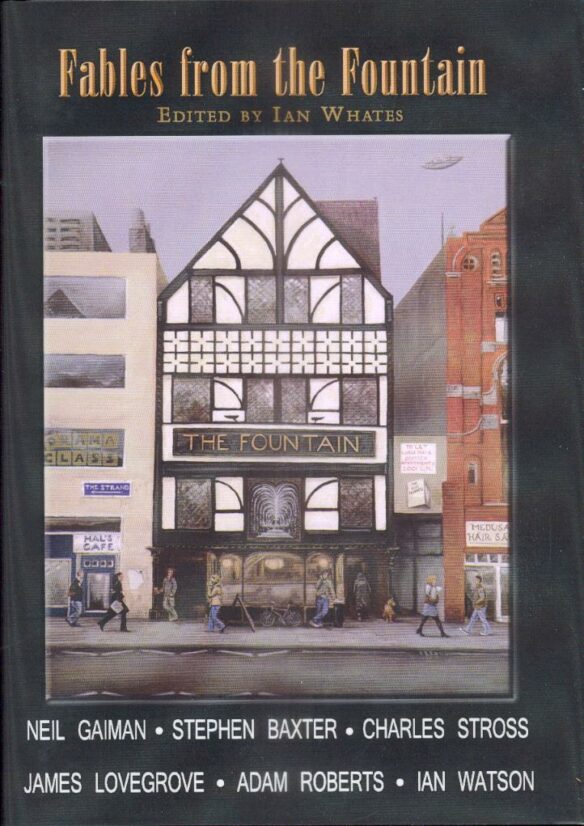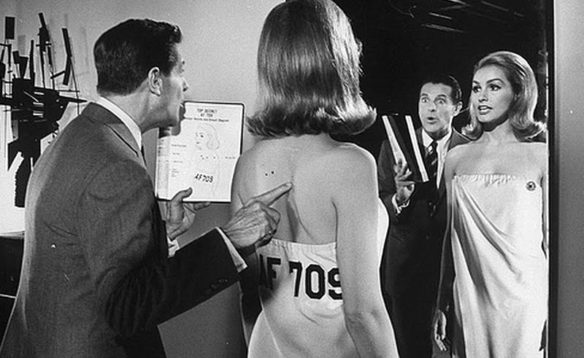(1) TONY AWARDS. Last night’s Tony Awards 2025 featured 14 winners of genre interest, if you can believe that! Maybe Happy Ending, about two helper-bots, was acclaimed Best Musical.
(2) IGNYTE AWARDS. The 2025 Ignyte Awards shortlist was released today. Public voting on the awards is open until August 15 at 11:59 p.m. Eastern.
(3) SHIRLEY JACKSON NOMINEES. The 2024 Shirley Jackson Awards nominees have been posted. The juried award is given for outstanding achievement in the literature of psychological suspense, horror, and the dark fantastic. The winners will be presented in-person on July 19 at Readercon 34,
(4) THERE’S H.L. GOLD IN THEM THAR HILLS. Joachim Boaz launches a marathon Galaxy magazine reread in “Magazine Review: Galaxy Science Fiction, ed. H. L. Gold (October 1950) (Simak, Sturgeon, MacLean, Matheson, Leiber, Brown, Asimov)” at Science Fiction and Other Suspect Ruminations.
Preliminary Note: I plan on reading all 116 issues of the influential, and iconic, SF magazine Galaxy under H. L. Gold’s editorship (October 1950-October 1961) in chronological order. How long this project will take or how seriously/systematically I will take it are complete unknowns. I am a reader of whim. I will choose whether to reread certain stories that I’ve previously covered. Serialized novels will only be reviewed after I complete the entire work and posted as separate reviews. Why Galaxy, you might ask?
First, I can’t escape the pull of 1950s science fiction focused on social commentary and soft science. Second, I am obsessed with 50s American politics during a time of affluence, the rise of TV and mass culture, and the looming terror of the Cold War. Third, there are a legion of well-known 50s authors I’ve yet to address in any substantial manner on the site who appeared behinds its illustrious covers. Fourth, H. L. Gold was interested in all different types of stories.
As SF Encyclopedia explains, Galaxy was an “immediate success” in part because “Astounding was at this time following John W Campbell Jr’s new-found obsession with Dianetics and was otherwise more oriented towards technology.” Gold’s interests, on the other hand, “were comparatively free-ranging: he was interested in psychology, sociology and satire and other humor, and the magazine reflected this.”…
(5) MOURNING BECOMES ELECTRIC. “AI Signals The Death Of The Author” writes David J. Gunkle at NOEMA. But it doesn’t bother him.
…I hold a different view. LLMs may well signal the end of the author, but this isn’t a loss to be lamented. In fact, these machines can be liberating: They free both writers and readers from the authoritarian control and influence of this thing we call the “author.”…
….[This] understanding of an author is not some kind of universal truth that has existed from the beginning of time. Rather, it is a modern conception. The “author” as we now know it comes from somewhere in the not-so-distant past; it has a history.
The French literary critic Roland Barthes, in his 1967 essay “The Death of The Author,” traced the roots of this now-commonplace idea to the modern period in Europe, beginning around the mid-16th century. Before then, people did of course write texts — but the idea of vesting responsibility and authority in a singular person was not common practice. In fact, many of the great and influential works of literature — the folklore, myth and religious scripture that we still read today — have circulated in human culture without needing or assigning them to an author.
The modern period, however, spawned a number of related intellectual and cultural developments in Europe that centered around what Michel Foucault later called a “privileged moment of individualization in the history of ideas.” In rejecting subservience to the papacy, the Protestant Reformation of the 16th century birthed an individualized faith. Then, in the following century, philosopher René Descartes built his rationalist philosophy on the statement “I think, therefore I am,” making all knowledge dependent on the certainty of self-conscious thought. Accompanying these innovations was the concept of personal property as an individual right, ensured and protected by the state.
The concept of the author, as both Barthes and Foucault demonstrate, emerges from the confluence of these historically important innovations. But this does not mean that the author as the locus of literary authority is just a subject for theory — it also evolved to be a practical matter of law. In 18th-century England and its breakaway North American colonies, the author became the responsible party in a new kind of property law: copyright. The idea of an author being the legitimate owner of a literary work was first introduced in London not out of some idealistic dedication to the concept of artistic integrity, but in response to an earlier technological disruption that permitted the free circulation and proliferation of textual documents: the printing press.
(6) TRUTH UNDER ATTACK. “Former Librarian of Congress Carla Hayden Speaks Out on CBS”. Hayden appeared on CBS Sunday Morning.
…Following Hayden’s dismissal, White House press secretary Karoline Leavitt said in a May 9 press conference that she had been dismissed because “we felt she did not fit the needs of the American people. There were quite concerning things she had done at the Library of Congress in the pursuit of DEI and putting inappropriate books in the library for children.” Leavitt did not elaborate on either accusation, nor did she acknowledge that perusal of the collections at the library of Congress is available only to visitors aged 16 or older, and must be done entirely on premises.
“When I heard those comments, I was concerned that there might not have been as much of an awareness of what the Library of Congress does,” Hayden said. In a voiceover, Costa explained to CBS viewers, “The library’s primary function is to fulfill research requests from members of Congress. It is not a lending library for the general public.”
Outcry over Hayden’s removal has been fierce, and Costa observed that information specialists with a reputation for being “quiet types” are “being loud” about the assault on libraries. “They’re being loud,” Hayden confirmed, “and it’s so humbling to have that outpouring of support.”…
(7) THE TRUE FAKE STORY. The Wall Street Journal uncovers “The Pentagon Disinformation That Fueled America’s UFO Mythology”. (Behind a paywall.)
A tiny Pentagon office had spent months investigating conspiracy theories about secret Washington UFO programs when it uncovered a shocking truth: At least one of those theories had been fueled by the Pentagon itself.
The congressionally ordered probe took investigators back to the 1980s, when an Air Force colonel visited a bar near Area 51, a top-secret site in the Nevada desert. He gave the owner photos of what might be flying saucers. The photos went up on the walls, and into the local lore went the idea that the U.S. military was secretly testing recovered alien technology.
But the colonel was on a mission—of disinformation. The photos were doctored, the now-retired officer confessed to the Pentagon investigators in 2023. The whole exercise was a ruse to protect what was really going on at Area 51: The Air Force was using the site to develop top-secret stealth fighters, viewed as a critical edge against the Soviet Union. Military leaders were worried that the programs might get exposed if locals somehow glimpsed a test flight of, say, the F-117 stealth fighter, an aircraft that truly did look out of this world. Better that they believe it came from Andromeda.
This episode, reported now for the first time, was just one of a series of discoveries the Pentagon team made as it investigated decades of claims that Washington was hiding what it knew about extraterrestrial life. That effort culminated in a report, released last year by the Defense Department, that found allegations of a government coverup to be baseless.
In fact, a Wall Street Journal investigation reveals, the report itself amounted to a coverup—but not in the way the UFO conspiracy industry would have people believe. The public disclosure left out the truth behind some of the foundational myths about UFOs: The Pentagon itself sometimes deliberately fanned the flames, in what amounted to the U.S. government targeting its own citizens with disinformation.
At the same time, the very nature of Pentagon operations—an opaque bureaucracy that kept secret programs embedded within secret programs, cloaked in cover stories—created fertile ground for the myths to spread….
(8) THE SHORT AND LONG OF IT. A Deep Look by Dave Hook devotes a post to “’John Carstairs: Space Detective’, Frank Belknap Long, 1949 Frederick Fell”.
The Short: I read the Frank Belknap Long collection John Carstairs: Space Detective, 1949 Frederick Fell, for my project of reading 1949 SFF. Frank Belknap Long has written some wonderful science fiction, but it’s not in this collection. My overall average rating for the five stories included is 3.15/5, or “Good”, which is one of the lowest ratings for a collection I have read and finished. Not recommended unless you are really, really interested in a detective who uses exotic, off planet botany to catch crooks…
(9) OCTOTHORPE. In episode 136 of the Octothorpe podcast, “When Do You Not Want to Talk About Games?”, John Coxon, Alison Scott, and Liz Batty, “finally have time to discuss Eastercon 2025 (Reconnect in Belfast) in more detail, and then we also discuss Seattle 2025, particularly the consultative votes.” An uncorrected transcript is available here.

(10) MATTIE BRAHEN OBITUARY. Author and singer-songwriter Mattie Brahen died June 9. Her husband, Darrell Schweitzer, made the announcement on Facebook.
Her first published story, “The Gift”, appeared in Marion Zimmer Bradley’s Fantasy Magazine in 1994. Over the years it was followed by a dozen other short stories, and three novels, Claiming Her (2003), Reforming Hell (2009), and Baby Boy Blue (2010).
Brahen and Schweitzer also gained fame as convention book dealers, among those interviewed in Forbes magazine’s 2014 article “Dealing In Science Fiction Classics At Readercon”.
She is survived by Darrell and her son, Brian.
(11) TODAY’S BIRTHDAY.
[Written by Paul Weimer.]
June 9, 1925 — Keith Laumer. (Died 1993.)
By Paul Weimer: Keith Laumer’s Retief novels, about the adventures of a rather forward thinking and two-fisted diplomat, made the first and strongest impression to me of Laumer’s work, and it is here that I will begin my discussion of it. I think it might also be the closest thing he has to his own heart, because he was a diplomat in the foreign service. He knew the archetypes and kinds of characters on both sides of the political fence, and that all goes into the blender of Retief. And who can resist a two-fisted active diplomat out among the stars? (I think of him as a first cousin to Poul Anderson’s Flandry.)
I also modeled one of my favorite PCs on him, Diplomat Ingrey Wererathe, who was indeed the most competent person in the Embassy, and that got him into all sorts of adventures and trouble. (The head Ambassador was too interested in political climbing to care– I suspect the GM knew who I was modeling Ingrey on and had read the Retief stories too).
Besides the best diplomat in science fiction (sorry, Bren Cameron, I take Retief over you when the chips are down), Laumer is next best known for the intelligent robot tanks, the Bolos. Since I came to the bolos after first encountering the board game OGRE, my inward conception of the Bolos is much more dark and menacing than they actually are in practice. But, nowadays, with the rise of LLMs and other not-AI AIs, and the big rise of drone technology, the Bolos seem more possible than ever before (so do OGREs come to think).
And if that wasn’t enough, Laumer also did a parallel Earths time patrol series, the Worlds of the Imperium. Once again in a parallel with Anderson, his Imperium is based on a potent and powerful Scandinavian polity. And it is the fun “body double across parallel Earths” story that might seem old hat now…but Laumer paved the way with it in Worlds of the Imperium.

(12) COMICS SECTION.
- Bob the Angry Flower complains about evil corporations.
- Bound and Gagged is evicted.
- Brewster Rockit reviews workplace safety signs.
- Reply All uses a callback.
- Rubes finds a history-making typo.
- Finding Dee is in monstrously bad taste.
(13) IN THE TIME BETWEEN BEATNIKS AND HIPPIES. Jeet Heer reviews Dan Nadel’s biography of Robert Crumb in “Cartoon Liberation | Robert Crumb and His Times” for the Southwest Review.
The cartoonist Robert Crumb was born in 1943, which he once observed was “the bloodiest year in the history of mankind.” Crumb was making no idle connection. Violence was Crumb’s birthright—both geopolitical carnage and more tawdry but still traumatic domestic abuse. This violence has marked his work and is one of the sources of its discomforting power, its ability to offend and shock even as it speaks to pervasive (if often taboo) human experiences and emotions. As Dan Nadel makes clear in his new biography, Crumb: A Cartoonist’s Life (2025), Crumb survived intense familial pain but has never been entirely free of the patterns of maltreatment that were implanted in him so early, which he triumphantly grappled with in his art but sometimes sadly replicated in his life….
(14) ROBOPOP. [Item by Lew Wolkoff.] Wait Wait…Don’t Tell Me! is a comedy news quiz on National Public Radio. Comedian Peter Sagal asks a three-person comedian panel, a celebrity guest, and call-in listeners questions about the week’s news. At the end of the show, the three panels are asks to forecast a future news item, giving funny answers. Here’s how part of this week’s show ended.
Sagal: Panel what will be this year’s hot summer read?
Adam Burke: Since AI will be doing all the reading, the big hit will be the Isaac Asimov classic, “You, Robot.”
You can hear the full show at NPR.org.
(15) WHEN KRYPTON WAS KANCELLED. “10 million dollars for 6 minutes of film down the drain: One of the most expensive deleted scenes in cinema is in this DC film” at 3DVF.
When Warner Bros. decided to cut a six-minute sequence from Superman Returns, they threw away one of the most expensive deleted scenes in movie history. The dark Krypton exploration sequence cost a staggering $10 million to produce, only to end up on the cutting room floor because executives deemed it too grim for the film’s overall tone….
… Inside the lost Krypton sequence
What exactly made this deleted scene so expensive? Singer originally crafted a completely different opening for the film – one that would have taken audiences on a chilling journey to Superman’s destroyed home planet.
A haunting exploration of Krypton’s remains
The sequence follows Clark Kent as he explores the remnants of Krypton, his birth planet. Picture this: no dialogue, just atmospheric storytelling as our hero walks through the desolate landscape of his origins. The scene was designed to be visually stunning but emotionally heavy, setting a much darker tone than what Warner Bros. ultimately wanted for their Superman revival….
(16) OMEGA MAN, THE NEXT GENERATION. Popular Science answers the question “In a world without people, how fast would NYC fall apart? Here’s the timeline.”
…Imagine the ceaseless cacophony of New York City suddenly stopped. No sirens wailed. No cars zoomed. No subways rumbled beneath sidewalks. All eight million New Yorkers disappeared overnight.
Now, imagine what would happen next….
By Year 50: A One-of-a-Kind Ecosystem
In the decades since humans abandoned New York, a “novel ecosystem” would emerge, says Tredici. “It’s not going to look like anything that’s ever existed anywhere in the world.”
Tredici points to Detroit as a case study. Today, crabapple trees—tough ornamentals native to the Central Asian mountains—blanket Detroit. “They actually will spread all over,” says Tredici, and after 50 years without humans, Central and Riverside Park’s crabapple trees would grow among a young forest full of London planetrees, honeylocusts, pin oaks, and Norway maples (the last three being common New York street trees). Nightshade vines and poison ivy would creep up buildings, and mosses and resilient weeds would cover the higher reaches of exposed windy skyscrapers….
(17) REMEMBERING ROBBY. In 2017, Bonhams auctioned the original Robby the Robot suit and Jeep from Forbidden Planet. It sold for over $5.3 million.
The New Atlas article tells a lot of details about the design and operation of the famed movie robot: “The original Robby the Robot goes up for auction”.
…But Robby was more than a suit. He included seven war-surplus electric motors to power his mechanical “scanners” and “brain,” plus a “mouth” made of blue neon tubes run by a 40,000 Volt power source run via a cable out of the robot’s heel or onboard batteries.Sitting so close to so much voltage was just one example of how hard Robby was on the actor inside him. Though Robby stands over six feet tall, the actor had to be very short to look out through the “mouth” with his face blacked up with matte black makeup to prevent being seen by the camera. The weight of the three parts of the robot were carried on a flying harness on the actor’s shoulders and a special frame was built to allow him to rest between takes. Even then, Robby could only walk on a completely flat surface with actor unable to see his feet and after a near tumble, the actor Frankie Darrow had to be replaced by Frank Carpenter because he was too shaken up to continue.Another important factor in Robby’s success is that he was designed to be portable, breaking down into three parts and placed in specially designed crates along with his effects control panel. After Forbidden Planet opened, Robby attended the premiere at Grauman’s Chinese Theater and then toured the country on a promotional tour. After that, Robby starred in the feature The Invisible Boy before embarking on a decades-long career, appearing in television programs like The Thin Man, The Twilight Zone, Columbo, Lost in Space, and The Addams Family, as well as various films, science fiction conventions, and charitable events up to this day.
Unfortunately, MGM didn’t take very good care of Robby and the prop was in poor shape when he and his car were sold to Jim Brucker in 1970 for display at Movie World/Cars of the Stars. In 1979, Robby was bought by filmmaker and special effect designer Bill Malone, who had already built a full scale reproduction of the robot from the original blueprints. Using his expertise, Malone restored the badly deteriorated bot, including casting new rubber hands and Perspex dome, which had rotted and yellowed respectively.
(18) SUNDAY IN THE PARK WITH SPOCK. CBS Sunday Morning reaches into the archives to share: “The final frontier of ‘Star Trek’? Outdoor theater”.
In 2012, the beloved original sci-fi series, which explored strange new worlds, arrived at a particularly strange one: Portland, Oregon, where summer theater in the park audiences welcomed a live performance of a classic “Star Trek” episode. Correspondent Lee Cowan went behind the scenes of a production going boldly where no theater project had gone before, in a “Sunday Morning” story that originally aired Aug. 12, 2012.
[Thanks to Mike Kennedy, Andrew Porter, John King Tarpinian, Joachim Boaz, Lew Wolkoff, Joyce Scrivner, Lise Andreasen, Chris Barkley, Cat Eldridge, SF Concatenation’s Jonathan Cowie, Mark Roth-Whitworth, Steven French, Kathy Sullivan, and Teddy Harvia for some of these stories. Title credit belongs to File 770 contributing editor of the day Jayn.]











